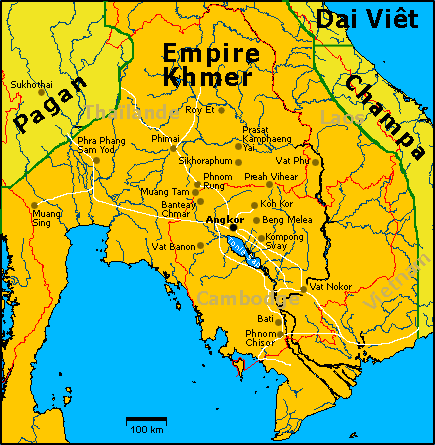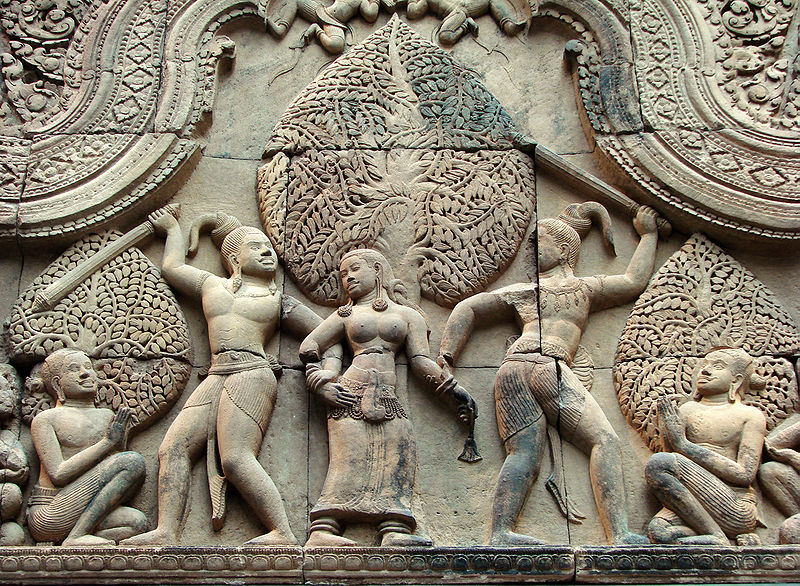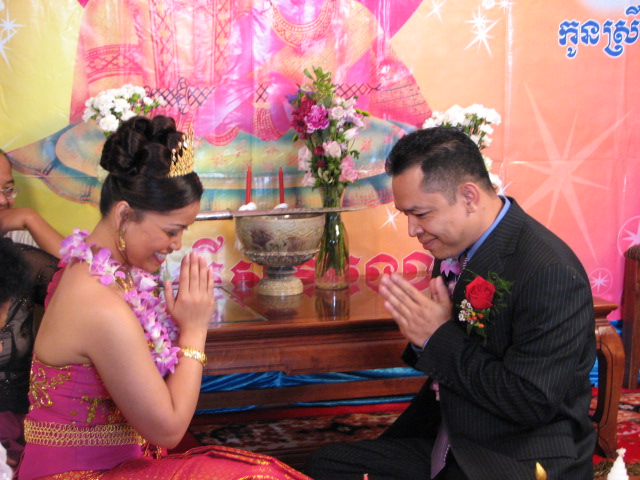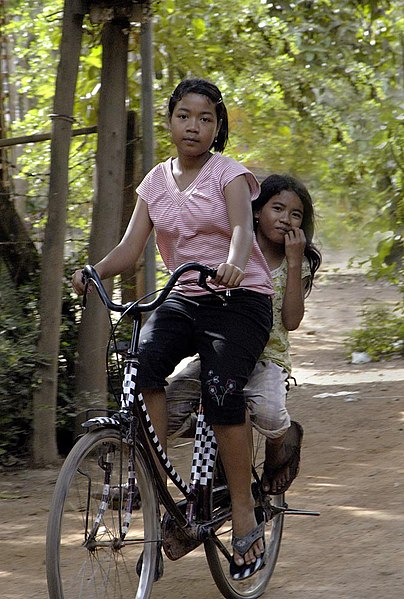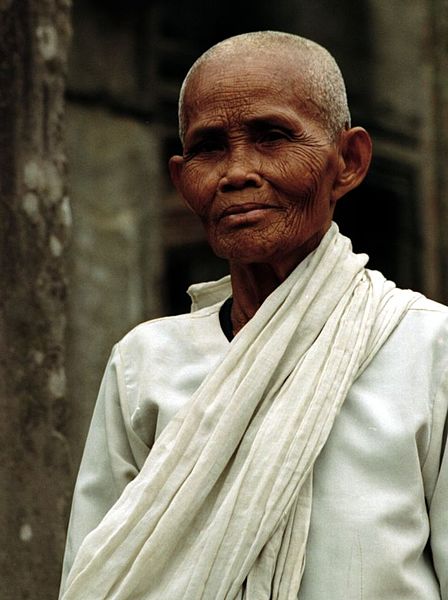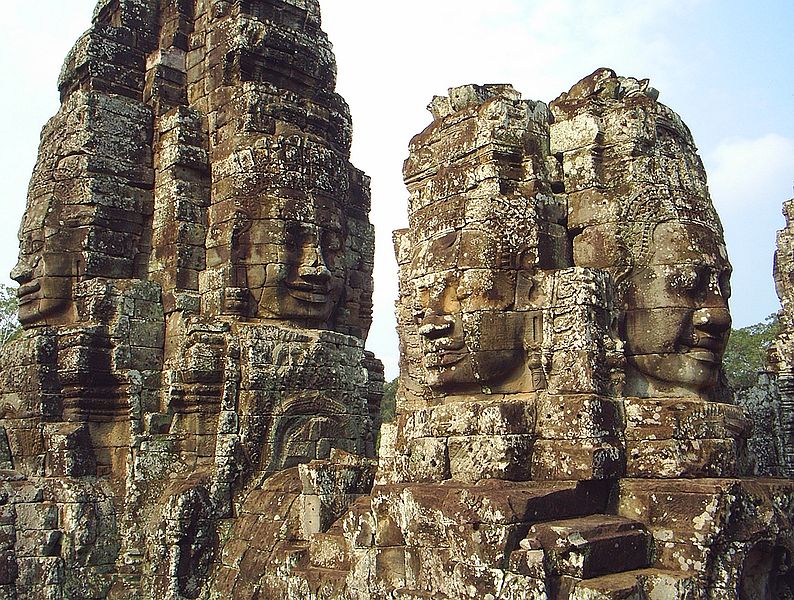
Jayavarman II - the founder of Angkor
Jayavarman II lived as a prince at the court of Sailendra in Java, whether as a royal hostage of Java's vassal kingdom, or for his education (or both), has not yet been established. Thus he brought the art and culture of Javanese Sailendran court to Cambodia. After he eventually returned to his home, the former kingdom of Chenla, he quickly built up his influence, conquered a series of competing kings, and in 790 became king of a kingdom called "Kambuja" by the Khmer. In the following years he extended his territory and eventually established his new capital of Hariharalaya near the modern Cambodian town of Roluos. He thereby laid the foundation of Angkor, which was to arise some 15 km to the northwest. In 802 he declared himself Chakravartin, in a ritual taken from the Indian-Hindu tradition. Thereby he not only became the divinely appointed and therefore uncontested ruler, but also simultaneously declared the independence of his kingdom from Java. Jayavarman II died in the year 834.
[edit] Yasodharapura - the first city of Angkor
Jayavarman II's successors continually extended the territory of Kambuja. Indravarman I (reigned 877 - 889) managed to expand the kingdom without wars, and he began extensive building projects, thanks to the wealth gained through trade and agriculture. Foremost were the temple of Preah Ko and irrigation works. He was followed by his son Yasovarman I (reigned 889 - 915), who established a new capital, Yasodharapura - the first city of Angkor.
The city's central temple was built on Phnom Bakheng, a hill which rises around 60 m above the plain on which Angkor sits. Under Yasovarman I the East Baray was also created, a massive water reservoir of 7.5 by 1.8 km.
11th century Cambodian sculpture of the Buddha
A 12 or 13th century relief at the Bayon temple in Angkor depicts the Khmer army going to war against the Cham.
At the beginning of the 10th century the kingdom split. Jayavarman IV established a new capital at Koh Ker, some 100 km northeast of Angkor. Only with Rajendravarman II (reigned 944 - 968) was the royal palace returned to Yasodharapura. He took up again the extensive building schemes of the earlier kings and established a series of temples in the Angkor area; not the least being the East Mebon, on an island in the middle of the East Baray, and several Buddhist temples and monasteries. In 950 the first war took place between Kambuja and the kingdom of Champa to the east (in the modern central Vietnam).
From 968 to 1001 reigned the son of Rajendravarman II, Jayavarman V. After he had established himself as the new king over the other princes, his rule was a largely peaceful period, marked by prosperity and a cultural flowering. He established a new capital near Yashodharapura, Jayenanagari. At the court of Jayavarman V lived philosophers, scholars and artists. New temples were also established: the most important of these are Banteay Srei, considered one of the most beautiful and artistic of Angkor, and Ta Keo, the first temple of Angkor built completely of sandstone.
After the death of Jayavarman V a decade of conflict followed. Kings reigned only for a few years, and were successively violently replaced by their successors until eventually Suryavarman I (reigned 1010 - 1050) gained the throne. His rule was marked by repeated attempts by his opponents to overthrow him and by military conquests. In the west he extended the kingdom to the modern Lopburi in Thailand, in the south to the Kra Isthmus. At Angkor, construction of the West Baray began under Suryavarman I, the second and even larger {8 by 2.2 km) water reservoir after the Eastern Baray.No one knows if he had children or wives
[edit] Suryavarman II - Angkor Wat
The 11th century was a time of conflict and brutal power struggles. Only with Suryavarman II (reigned 1113 - 1150) was the kingdom united internally and extended externally. Under his rule, the largest temple of Angkor was built in a period of 37 years: Angkor Wat, dedicated to the god Vishnu. Suryavarman II conquered the Mon kingdom of Haripunjaya to the west (in today's central Thailand), and the area further west to the border with the kingdom of Bagan (modern Burma), in the south further parts of the Malay peninsula down to the kingdom of Grahi (corresponding roughly to the modern Thai province of Nakhon Si Thammarat), in the east several provinces of Champa and the countries in the north as far as the southern border of modern Laos. Suryavarman II's end is unclear. The last inscription, which mentions his name in connection with a planned invasion of Vietnam, is from the year 1145. He probably died during a military expedition between 1145 and 1150.
There followed another period in which kings reigned briefly and were violently overthrown by their successors. Finally in 1177 Kambuja was defeated in a naval battle on the Tonle Sap lake by the army of the Chams, and was incorporated as a province of Champa.
[edit] Jayavarman VII - Angkor Thom
Map of Khmer empire under Jayavarman VII.
The future king Jayavarman VII (reigned 1181-1219) was already a military leader as prince under previous kings. After the Cham had conquered Angkor, he gathered an army and regained the capital, Yasodharapura. In 1181 he ascended the throne and continued the war against the neighbouring eastern kingdom for a further 22 years, until the Khmer defeated Champa in 1203 and conquered large parts of its territory.
Jayavarman VII stands as the last of the great kings of Angkor, not only because of the successful war against the Cham, but also because he was no tyrannical ruler in the manner of his immediate predecessors, because he unified the empire, and above all because of the building projects carried out under his rule. The new capital now called Angkor Thom (literally: "Great City") was built. In the centre, the king (himself a follower of Mahayana Buddhism) had constructed as the state temple the Bayon, with its towers bearing faces of the boddhisattva Avalokiteshvara, each several metres high, carved out of stone. Further important temples built under Jayavarman VII were Ta Prohm, Banteay Kdei and Neak Pean, as well as the reservoir of Srah Srang. Alongside, an extensive network of streets was laid down, which connected every town of the empire. Beside these streets 121 rest-houses were built for traders, officials and travellers. Not least of all, he established 102 hospitals.
[edit] Zhou Daguan - the last blooming
After the death of Jayavarman VII, his son Indravarman II (reigned 1219-1243) ascended the throne. Like his father, he was a Buddhist, and completed a series of temples begun under his father's rule. As a warrior he was less successful. In the year 1220 the Khmer withdrew from many of the provinces previously conquered from Champa. In the west, his Thai subjects rebelled, established the first Thai kingdom at Sukhothai and pushed back the Khmer. In the following 200 years, the Thais would become the chief rivals of Kambuja. Indravarman II was succeeded by Jayavarman VIII (reigned 1243-1295). In contrast to his predecessors, he was a Hindu and an aggressive opponent of Buddhism. He destroyed most of the Buddha statues in the empire (archaeologists estimate the number at over 10,000, of which few traces remain) and converted Buddhist temples to Hindu temples. From the outside, the empire was threatened in 1283 by the Mongols under Kublai Khan's general Sagatu. The king avoided war with his powerful opponent, who at this time ruled over all China, by paying annual tribute to him. Jayavarman VIII's rule ended in 1295 when he was deposed by his son-in-law Srindravarman (reigned 1295-1309). The new king was a follower of Theravada Buddhism, a school of Buddhism which had arrived in southeast Asia from Sri Lanka and subsequently spread through most of the region.
In August of 1296, the Chinese diplomat Zhou Daguan arrived at Angkor, and remained at the court of king Srindravarman until July 1297. He was neither the first nor the last Chinese representative to visit Kambuja. However, his stay is notable because Zhou Daguan later wrote a detailed report on life in Angkor. His portrayal is today one of the most important sources of understanding of historical Angkor. Alongside descriptions of several great temples (the Bayon, the Baphuon, Angkor Wat, for which we have him to thank for the knowledge that the towers of the Bayon were once covered in gold), the text also offers valuable information on the everyday life and the habits of the inhabitants of Angkor. this was a good source for the emperor
[edit] Decline and the end of Angkor
There are few historical records from the time following Srindravarman's reign. The last known inscription on a pillar is from the year 1327. No further large temples were established. Historians suspect a connection with the kings' adoption of Theravada Buddhism: they were therefore no longer considered "devarajas", and there was no need to erect huge temples to them, or rather to the gods under whose protection they stood. The retreat from the concept of the devaraja may also have led to a loss of royal authority and thereby to a lack of workers. The water-management apparatus also degenerated, meaning that harvests were reduced by floods or drought. While previously three rice harvests per years were possible - a substantial contribution to the prosperity and power of Kambuja - the declining harvests further weakened the empire.
Its western neighbour, the first Thai kingdom of Sukhothai,after repelling Angkorian hegemony, was conquered by another stronger Thai kingdom in the lower Chao Phraya Basin, Ayutthaya, in 1350. From the fourteenth century, Ayutthaya became Angkor's rival. According to its accounts, Ayutthaya launched several attacks. Eventually it was said, Angkor was subjugated. Siamese army drew back, leaving Angkor ruled by local nobles, loyal to Ayutthaya. The story of Angkor faded from historical accounts from then on. The territory, later called 'Cambodia' and 'South Vietnam' was ruled by Siam for many centuries, until the arrival of French explorers and their systematic overthrow of local governors. To this day, many locations throughout Vietnam and Cambodia have Thai (Tai/Dai) names. Siam Reap (Siam Border) and Talay Sab (big lake) in Cambodia, Dalat (market) in S. Vietnam, Dinh Biec (wet earth) in N. Vietnam being examples.
NOTE: There is evidence that the "Black Death" had an impact on the situation described above, as the "plague" first appeared in China around 1330 and reached Europe around 1345. Most seaports along the line of travel from China to Europe felt the impact of the disease, which had a severe impact on life throughout South East Asia.
The new centre of the Khmer kingdom was in the southwest, at U-Thong (named for the first King of Ayutthaya), in the region of today's Phnom Penh. However, there are indications that Angkor was not completely abandoned. One line of Khmer kings could have remained there, while a second moved to Phnom Penh to establish a parallel kingdom. The final fall of Angkor would then be due to the transfer of economic - and therewith political - significance, as Phnom Penh became an important trade centre on the Mekong. Costly construction projects and conflicts over power between the royal family sealed the end of the Khmer empire.
Ecological failure and infrastructural breakdown is a new alternative answer to the end of the Khmer Empire. The Great Angkor Project believe that the Khmers had an elaborate system of reservoirs and canals used for trade, travel and irrigation. The canals were used for the harvesting of rice. As the population grew there was more strain on the water system. Failures include water shortage and flooding. To adapt to the growing population, trees were cut down from the Kulen hills and cleared out for more rice fields. That created rain runoff carrying sediment to the canal network. Any damage to the water system would leave an enormous amount of consequences.1
In any event, there is evidence for a further period of use for Angkor. Under the rule of king Barom Reachea I (reigned 1566 - 1576), who temporarily succeeded in driving back the Thai, the royal court was briefly returned to Angkor. From the 17th century there are inscriptions which testify to Japanese settlements alongside those of the remaining Khmer.
A plan of Angkor Wat created by a Japanese pilgrim from c. 1623 to 1636
The best-known tells of Ukondafu Kazufusa, who celebrated the Khmer New Year there in 1632.





